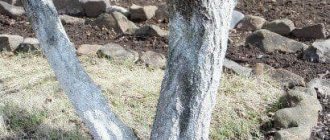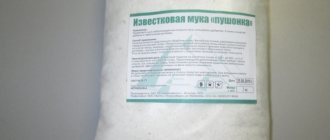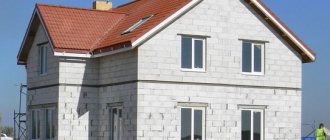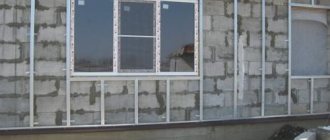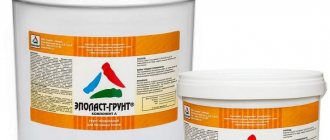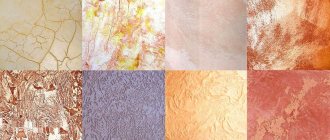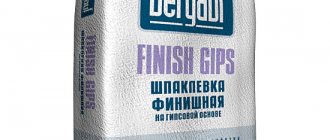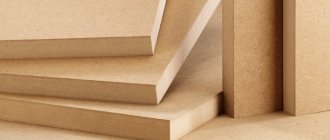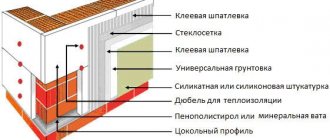Category: Organic fertilizers Reading time: 8 min · Views: 859
Lime is widely used in construction and agriculture. Slaked lime is obtained by mixing dry lime with water. In horticulture, lime is used to deoxidize the soil, correct the composition of the fertile layer, and to protect trees from harmful insects using whitewash. Let's consider all the ways to use this material in the country, as well as the process of preparing the working solution.
Cooking process
- Any lime must be slaked (regardless of its composition). Usually it is bred into dough or fluff, depending on its further purpose. Quicklime is suitable only as a strengthening and binding material in construction, but not for whitewashing;
- To prepare lime for whitewashing ceilings, trees, chicken coops and other utility rooms, only slaked lime is used, which is diluted in different proportions of water;
- To prepare fluff, take 1 part of lump lime and place it in a special container for slaking. The container must be rust-free and deep enough. Cold water is poured into the same container. Proportions are taken based on the mass of lime. For example, 4 kg of lime requires 4 liters of water.
The lime solution gradually begins to heat up to 150 degrees, boil, hiss and splash with greasy, hot drops. Boiling time averages from 8 to 30 minutes. All this time you need to stir the solution with a stick.
There is another way to prepare whitewash
To begin, prepare a small amount of water, then dilute approximately 2-3 kg of pre-slaked lime in it. You can add another 400-500 g of dyes pre-soaked in water to the resulting composition, and 50-100 g of table salt will also do.
All ingredients are thoroughly mixed. Water is gradually introduced into the solution, the volume is increased to 10 liters. The composition, of course, can be slightly blued with ultramarine.
There is, of course, ready-to-use whitewash. It resembles a thick plastic mass consisting of a synthetic binder (for example, PVA dispersion), various pigments, and various moisture-protective additives.
The consumption of such whitewash is approximately 100-300 g per 1 m2.
The finished whitewash can be diluted with water, strictly adhering to the requirements specified in the instructions. After this, the mixture is mixed well to obtain a plastic, homogeneous substance.
This composition is applied to the ceiling in approximately 1-3 layers. Naturally, the more layers, the higher the whitewash consumption.
Lime prepared for whitewashing
For precautionary purposes and personal protection, it is necessary to wear special glasses, a canvas suit, and gloves. Next, your actions will be:
- It is not recommended to use slaked lime immediately. It must be kept for at least 15-30 days with the lid closed (can be in the cellar). Such a solution will perfectly cope with all its functions, lay down evenly and disinfect the surface;
- The question is often asked about what is added to lime for whitewashing. Let's look at the fluff. To whitewash the fluff, dilute it with water to the required consistency. For whitewashing, the required density can be easily determined. Water is gradually added to the solution and checked with a stick. An even, dense white tint remains on the stick;
- Lime dough is prepared according to a similar principle. But a much smaller amount of water is shaved in relation to lime. For 1 part of lump clay, 40% cold water is added to the container. Water is added carefully and gradually so that all lumps have the opportunity to dissolve and sizzle. This dough is used for various construction works - masonry, plastering.
Description
Lime belongs to the group of carbonates and is a product of the processing of limestone, chalk and other substances of this group. It contains dolomite and calcite - valuable elements for processing cultivated plants. Dolomite and calcite are widely used in gardening as compounds that repel rodents and other pests, and they also improve the mechanical characteristics of the soil.
Note! When diluting lime, you should not use hot water so that the powder retains its valuable substances.
Many gardeners are interested in the question: is lime considered a mineral fertilizer or organic? It depends on its composition. If the base element is dolomite, then we are talking about a mineral fertilizer. This is some limitation in the use of lime as a plant fertilizer.
Note! Slaked lime is even used in the food industry as an additive under the code E-529.
Calcium lime is organic in its properties, so it is more often used in summer cottages than dolomite lime. Calcium lime can be slaked or quicklime. Slaked lime is called fluff.
Slaked lime is also called hydrate lime, as it is diluted in water. For 3-4 liters of water take 10 kg of dry matter. As a rule, lump lime is used. Instead, you can buy fluff (powdered lime), which is already prepared for dilution with water.
Whitewash consumption
For example, 0.5 liters of liquid whitewash may be enough for 1 m2 of prepared surface. Although such consumption is only possible if you previously had at least a little experience in handling brushes and whitewash.
If you want to avoid unwanted overspending, then practice applying whitewash. Otherwise, you risk damaging windows and furniture, and also spending as much as 1.5 liters or more instead of 0.5 liters. The expense will be quite impressive.
Whitewashing is a process that does not need to be rushed. The more carefully you whitewash the ceiling, the more elegant it will look.
An example of calculating consumables for whitewashing
For example, there is a need to whitewash the walls of a room measuring 4*5 m and 2.5 m high. It will not be difficult to calculate the whitewash area. To do this, multiply the height of the room by the perimeter.
2*2.5*(5+4) =45 sq. m.
If there is a need to whitewash the ceiling, then 5*4=20. sq. m
As a result, 20+45=65 sq. m
0.5*65=32.5 l of solution.
To obtain a similar amount of solution, you should dilute about 8-10 kg of lime, because from 1 kg of lime on average you will get 3.5-4 liters of solution.
Whitewashing the ceiling
When painting ceilings, take into account the direction of light rays penetrating the windows. If you work with a brush, then the last layer of whitewash is applied towards the light (towards the window), and the previous one - on the contrary, across. Otherwise, no matter how carefully the work is done, brush marks will be visible on the ceiling. The brush is used so that its strokes are uniform and the whitewash is applied in thin, even layers. In order for the surface to be smooth and clean, it is necessary not only to work competently with a brush, but also to correctly pick up the coloring composition with the brush. It must be shaken periodically with a brush: this gives it uniformity and prevents sediment from forming at the bottom. You can also stir it thoroughly with a stick from time to time.
Another option for applying whitewash is using a paint sprayer. They can use a regular vacuum cleaner equipped with a special attachment that can be bought at a hardware store. When working with a paint sprayer, it is necessary to ensure the uniformity and cleanliness of the solution: any small particle that does not dissolve in it can clog the opening of the sprayer and in some cases lead to its damage. To uniformly whitewash the surface, the solution must be applied in two mutually perpendicular directions, that is, crossing the layers. The speed of movement must be uniform; you cannot hold the jet of whitewash in one place longer than in others.
Whitewashing with lime. For whitewashing with lime, so-called lime milk is used, which is obtained from 1 part slaked lime and 3 parts water. Lime milk is a strong disinfectant. It destroys bacteria and prevents the accumulation and reproduction of bedbugs in residential areas.
The crushed lime is placed in a large metal, enamel or wooden container, poured with cold water and stirred with a wooden spatula until the cream becomes thick. When slaking, the lime generates a lot of heat and splashes, so you need to be careful.
Whitewashing of ceilings with a lime composition is carried out on a slightly damp surface. Paint durability increases if table salt is added to the prepared solution (25-50 g per 5 liters of whitewash).
Whitewashing with chalk. Chalk mortar is prepared in the same proportion as lime mortar. For 3 parts water, take 1 part chalk or commercially available chalk paste. It is much more convenient to use the paste, as it will eliminate the long and painstaking process of grinding and sifting chalk.
Place chalk or paste in a container and gradually add water to the required amount, thoroughly mixing the solution. Then it is filtered through cheesecloth. Large parts of chalk remain on the gauze, increasing material consumption; This must be taken into account when purchasing chalk.
To avoid a yellowish tint to the ceiling, add a little blue or ultramarine to the whitewash. However, this should be done with extreme caution, otherwise an unintended “blue sky” effect may occur overhead.
To give the whitewash layer strength, you can add wood glue to it at the rate of 60-80 g per 3 liters of solution.
The ceiling can also be painted with colored paints, for which aniline dye is added to the composition. In this case, it is better to first experiment with the finished whitewash on some surface (for example, on a wall, also intended for repair).
Ready-made colorful compositions. Before use, the finished whitewash is diluted with water and mixed. Apply with a brush, brush or spray gun in 1-3 layers, periodically drying for 2-3 hours. Whitewash consumption - 100-120 g per 1 m2. In addition to the fact that the finished whitewash does not require additional preparation before use, it has increased strength compared to regular chalk.
Read more: Repair of ceilings made of prefabricated reinforced concrete slabs Installation of suspended ceilings Defects in ceilings covered with wallpaper Finishing the ceiling with Vinistene and foam film Pasting ceilings with self-adhesive wallpaper Pasting ceilings with liquid wallpaper Pasting ceilings with vinyl wallpaper Pasting ceilings with linkrust Preparation of wallpaper Preparing surfaces before painting the ceiling
Ceilings and walls are whitened with lime to strengthen the plaster, as well as to disinfect premises such as a chicken coop, basement, barn. Outbuildings are whitewashed both outside and inside. Therefore, it is important to know what lime consumption will occur during whitewashing.
How to dilute lime for whitewashing walls
To prepare whitewash, it is best to purchase quicklime in the form of lumps (it has an indefinite shelf life). In order to obtain whitewash from lumps of lime, the raw materials will have to be quenched. Slaking lime is quite easy, but at the same time you need to follow some recommendations and observe safety precautions when working.
So, in order to properly prepare a lime mortar you need:
- Grind large lumps of lime and place them in a metal container (taking into account the future volume of the solution).
- Pour one part of the solution into three parts of cold water and mix thoroughly.
- Cover the container with a lid and leave it for 6 hours (reacting with water, the solution may bubble for the first 10-15 minutes). Therefore, it is not superfluous to protect the skin and mucous membranes from contact with drops of the solution. Otherwise you may get burned.
- Strain the solution through a sieve to remove small, undissolved particles and debris.
Cooking is complete. The thick solution can be diluted with water to the desired consistency. Tint dyes should be added in dissolved form to the finished whitewash. So, for example, in order to obtain a blue solution, you can add 20 g of household blue to the whitewash.
To prevent lime from smearing after application and staining clothes, as well as to increase its strength, experts recommend adding drying oil and table salt to the solution.
How much to add ingredients depends on the volume of the resulting solution. So, for 5 liters of milk of lime, 10 grams of both salt and drying oil are usually added.
Where is lime whitening used?
Lime has excellent antiseptic properties, and it is also inexpensive. Lime whitewash, due to the fact that it is a good antiseptic, is recommended for medical institutions, including schools and kindergartens.
You can whitewash a basement or garage with lime - the white ceiling and walls will make it lighter, and it’s also not expensive. Lime whitewash also creates a durable film, so it will not remain on clothes when it comes into contact with the wall.
Features and recommendations for whitewashing walls with lime
In order to whitewash walls and ceilings, you do not need to have special skills: almost every package of lime contains instructions for use. However, in order to get a smooth and beautiful white surface, you need to know some features of applying lime. So, before whitewashing, the surface of the ceiling and walls must be carefully prepared: remove the old coating and wash thoroughly.
In addition, in order for the lime to lie evenly and not swell, you must use the following recommendations:
- To get the best result, you should use a spray gun. In this case, it is necessary to hold the tool at a right angle. It is better to choose a spray gun that has a compressor.
- The nozzle of the sprayer or spray gun should be kept at a distance of 150-200 mm from the surface. Apply lime from a sprayer using circular, smooth movements.
- Brick walls can be whitewashed with a natural brush. Before whitewashing, the brush must be soaked in warm water for several hours.
- When working with a brush, the second layer of whitewash must be applied in the direction of the light: this way the streaks from the tool will be less noticeable.
- It is highly not recommended to use it for applying whitewash: when rolling the second layer of whitewash, the first one may not hold up, and the lime will move away from the surface.
- It is best to treat surfaces with lime in cloudy weather. So, bright sun rays will not be able to distort the perception, and the coverage will be uniform.
In addition, it is necessary to work in protective equipment. So, you should wear safety glasses over your eyes, cover your hair and skin with a cloth, put a respirator or gauze mask on your face, and protect your hands with rubber gloves.
How to whiten correctly?
1. Find a master, but he is unlikely to work for low pay. If you want to save money, you should whiten it yourself.
2. Do-it-yourself whitewashing is not a very difficult job, but it is dirty and unpleasant. Before starting work, you should cover the furniture and floors with film, or completely vacate the room. You should also prepare protective clothing for yourself.
Lime consumption
The consumption of whitewash will, first of all, depend on the surface being treated and the method of its application. If you apply whitewash with a brush, the consumption will increase. Smooth walls will require less whitewashing than brick walls. Approximate consumption for smooth walls per 1 m² is approximately 0.5 liters of finished whitewash.
Quicklime and slaked lime are available for sale. Slaked lime is often sold in the form of powder - lime paste and fluff lime.
1. Fluff lime is diluted in the ratio of 1 kg of this powder per 3 liters of water. One package weighing 2 kg should yield approximately 6 liters of whitewash. This whitewash should be enough for 12 m² of surface, but only if the whitewash is not applied to the brickwork.
2. Ready lime dough should be diluted as follows: for 1 kg of dough, about 3 liters of water. Considering that with one liter of whitewash you can whitewash about two squares of walls, it is quite easy to calculate how much lime paste will be needed.
3. Quicklime, lump, should first of all be quenched, and only then diluted with water.
4. Slaking lime is poured with water in a ratio of approximately 1:1. As a result of quenching, you should get a powder. If you add three times more water, you will get a lime dough. To prepare the taken lime for whitewashing, the dough or powder is diluted with water. If you take 1 kg of quicklime, you should get 10 liters of whitewash, which will already be ready for use.
It is difficult to calculate whitewash consumption to the nearest square. Therefore, given that lime is an inexpensive material, it won’t be a big deal if you buy a few extra packages.
Lime consumption per 1 m2 during whitewashing
If you use lime, then the average consumption for a ceiling treated with putty is 500 grams per square (accordingly, you need the total area of the ceiling that needs to be whitened, multiplied by 0.5 liters, we get an approximate number of liters) Why exactly approximate, and not exact - since the tools used for whitewashing are different, and each master has his own professionalism, the consumption will be different. 0.5 liters is if you whiten in two layers with a special brush, but if you whiten with a spray bottle, the consumption will be less. But even if you need to whiten in three layers, this does not mean that you need to add another 0.25 liters per square, since the third layer will require less consumption. Now about the dry mixture: 1 kilogram of lime after dilution produces 3.5-4 liters of the finished solution.
Consumption of various types of paint per 1m2
Water is gradually added to the solution, after which it is checked with a stick. The stick should have a dense and even white tint.
3. Lime dough is prepared according to a similar principle. However, much less water will be needed. 40% water is added to 1 part clay. Water is added gradually and carefully so that all lumps fizz and can dissolve. Such dough is used in many construction works - plastering, masonry, and so on.
- Kitchen living room design
- How to level the walls?
- Do-it-yourself boiler repair - How to repair a boiler yourself?
- How to paint wallpaper?
Comments: 0
Lime milk consumption rate for whitewashing
What is the consumption of lime during whitewashing? The cooking method itself and what tools may be needed. We will talk about this later in this article. Whitewashing the ceiling Lime is a construction product that is produced by special firing of rocks. To prepare lime, the following are mined: chalk, limestone, shell rock, dolomitized limestone. Lime can be divided into types, depending on the rock from which it was extracted. Types of lime based on the main oxide:
- Calcium;
- Magnesian;
- Dolomite.
According to the method of extinguishing there are:
- Medium extinction;
- Fast extinction;
- Slow extinction.
In order to prepare lime for whitewashing you will need: lump lime, stirring stick, water, container. Cooking process
- Any lime must be slaked (regardless of its composition).
Advantages of whitewashed ceilings
- Environmental friendliness: the materials included in the whitewash are environmentally friendly.
- Vapor permeability: after finishing, whitewashed ceilings contain small pores on the surface that absorb moisture and freely evaporate it through themselves.
Such ceilings “breathe”.
- Labor intensity: anyone can whitewash the ceiling with their own hands, and we will look at how best to do this later in the article.
- Cost of materials and work: this finishing option is available to everyone, since the costs will be minimal.
- Weight: whitewash for the ceiling weighs practically nothing, and therefore does not create additional load on the ceiling.
- In addition, whitewashing the ceiling does not take away the height of the room, unlike, for example, suspended structures, which need to be lowered by 5-15 cm or even more.
Applications of slaked lime
Typically, streaks from whitewash remain when it is applied with a “broom”
Lime is an excellent binding material that imparts plasticity to cement mortar. Whitewashing with slaked lime has proven itself to be excellent when finishing bathroom ceilings, walls in swimming pools, closets, basements, and garages. It is used for whitewashing chicken coops, pigsties, and cowsheds. The film formed on the surface has good resistance to moisture and is environmentally friendly. Tree trunks in the garden and along highways are also whitened with lime.
The disadvantages of whitewashing with lime include the likelihood of stains, stripes, streaks, and bubbles appearing on the surface. This happens if the rules for preparing the mixture are violated.
Disadvantages of whitewashed ceilings
In the bathtub and toilet, whitewash, in principle, will last its intended period.
